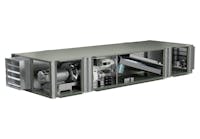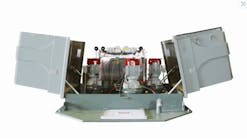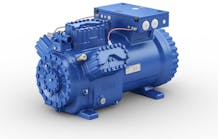Editor's note: This article on commissioning raised-floor plenums is the third in an ongoing series on raised- floor systems. The first, “Raised-Floor Environments for Offices, Schools and Data Centers” (August 2004), identified the broad range of raised-floor plenum applications. The second, “Specifying Underfloor Air Distribution Plenums” (November 2004), appeared in the annual HPAC Engineering Specification Guide. The fourth article in this series will focus specifically on the growing use of raised-floor systems in schools and universities and is slated to be published in May 2005.
Commissioning is vital to the energy and operational performance success of any mechanical engineering project including raised-floor systems. In fact, experience shows that data center commissioning can achieve an improvement between 10 and 30 percent in energy and operational performance. The intent of this article is to highlight some of the critical techniques and features to consider when commissioning raised-floor plenums.
Testing and air balancing of ductwork systems is commonplace and, although it is recognized as a critical activity, remains one that is also considered to be often flawed. The interior of a duct predominantly represents a clean, unobstructed path for air to pass, yet balancing ductwork systems and minimizing leakage usually proves to be a challenging task. However, balancing a traditional ducted system could be characterized as far less challenging when compared to a raised-floor plenum. Some reasons for this include:
-
The interior of a raised-floor plenum is far from unobstructed due to pedestals, columns, cabling, piping, etc.
-
The quantity and linear footage of seams and, therefore, air leakage potential, is magnitudes greater because this includes the perimeter of every floor tile.
-
The number of penetrations in a raised floor plenum (e.g., cable openings in tiles) has a major impact on performance and is a condition not found in ductwork systems.
Although the need for at least the testing and balancing portion of commissioning should be obvious for a raised-floor system, it is often not given the attention it requires. Possibly one of the reasons is the lack of clearly defined responsibilities between the trades because the construction of a raised-floor plenum usually involves more than just the HVAC trade. On the vast majority of projects, the HVAC trade is not the lead trade for constructing a raised-floor system or plenum.
Even within the HVAC trade itself, a classical debate is who should perform the testing and balancing of a ductwork system: the HVAC contractor, a sub-consultant hired by the HVAC contractor, or a completely independent agent hired directly by the owner. A similar debate often rages over whether the commissioning agent should be an independent entity or the project's consulting engineer.
In the case of commissioning a raised-floor plenum, the decision can be more complex because it involves multiple trades. In many cases, it is not as important to decide who performs the raised-floor commissioning, but rather that it actually occur and achieve the desired results. In many cases, it ultimately comes down to which consultant or contractor the client trusts and feels comfortable working with.
Photos A and B reveal some common installations and highlight the challenges of achieving effective air delivery. Figure 1 is a computational-fluid-dynamics (CFD) output which highlights the poor distribution of air within a raised floor plenum. This poorly distributed air can dramatically impact performance (comfort or equipment cooling), as well as energy usage.
Mission-critical facilities, such as data centers, often have major temperature variations and hot spots that must be resolved because they represent a risk to the data-center's uptime. In the case of offices and schools, the raised-floor performance is often overlooked, which is a mistake.
PRE-DESIGN AND DESIGN PHASES
There are a number of interdependencies involved with most design decisions. In the case of raised-floor plenums, the interdependencies and resultant tradeoffs between the various project trades can be particularly significant.
The types of things to discuss with the owner and holistically address include spatial considerations, interdisciplinary issues, and the overall quality and performance desired. For example, the performance of a 12-in.-high raised-floor cavity can vary from easily meeting the performance criteria to failing to meet the performance criteria. Consider the following two scenarios:
Scenario 1: The cfm required for the space it serves is average or below average and the plenum is dedicated to air so it contains no cabling and only minimal piping.
Scenario 2: The cfm required for the space it serves is extreme and the plenum is packed with disorganized cabling.
Scenario 1 and 2 demonstrate that the floor height decision is not an independent one. One good solution for Scenario 2 would be to raise the floor height to where the presence of the cabling is insignificant and so is the volume of air. Therefore, some of the interdependent issues to identify and clearly define include:
-
Plenum contents.
-
Load characteristics.
-
Frequency and impact of change.
-
Airtightness of the raised-floor plenum.
Plenum contents can have a major impact on the raised-floor plenum performance. During the pre-design phase, the contents and their impact should be conceptually identified. The following list of questions is a good place to start in this process.
-
Is the cable routing unstructured or structured?
-
Is the plenum occupancy for piping: plumbing, HVAC, and fire protection?
-
Is there plenum occupancy for cabling: power, signaling, and voice/data?
-
What is the percentage of vertical obstruction for the piping?
-
What is the percentage of vertical obstruction for the cabling?
These questions may only provide an engineer with enough knowledge to make an educated guess; however, the importance and impact of this educated guess cannot be emphasized enough. These initial decisions can have a major impact on raised-floor plenum performance.
Figure 2 provides a simple definition of percentage of vertical obstruction: obstruction height (Ho) divided by plenum height (Hp) using different types of obstructions in a floor plenum. Photo A shows a real example of a 40-percent vertical obstruction.
Load characteristics should profile the load in terms of required capacity and how uniformly the load is distributed (e.g., planned or unplanned high density zones). Based on the functionality of the space, the cooling loads may be non-uniform and require additional cooling at concentrated areas. The increased airflow at these locations needs to be coordinated with the underfloor fluid dynamics and areas with higher congestion (e.g., where cabling originates, such as at a panel) that may affect delivery to the areas with a higher-density cooling requirement.
One of the advantages of a raised-floor installation is its flexibility in terms of functionality and layout. This flexibility may result in changes made to the systems that are distributed throughout the raised floor. The frequency and magnitude of these changes should be discussed and agreed upon because they can greatly impact the plenum performance and design. There are too many examples of small changes in a data center environment, such as moving or adding equipment, that end up having a significant negative impact on performance.
ASHRAE Technical Committee TC 9.9 (Mission Critical Facilities, Technology Spaces & Electronic Equipment) is investigating sensitivity modeling to identify the thresholds impacting airflow distribution and performance. In the case of data centers, there are often more than 10 parameters or variables that impact performance. This makes it difficult to predict performance or even identify the various scenarios to simulate during functional testing (e.g., failure modes, anticipated and unanticipated changes).
How airtight the plenum needs to be and how cable openings are handled and managed are also important factors to consider.
Whether an approach similar to the one just described or some other approach is used, it is important to evaluate the tradeoffs and carefully decide on an optimum raised-floor height and the permissible plenum contents, whether by type or by using a metric such as vertical obstruction. It is also important to quantify the performance metrics that will be used to measure the effectiveness of the design and construction. These include leakage rates for the assembly, percent of penetrations/associated leakage rate limit, plenum temperatures, plenum pressures, and air velocities.
CONSTRUCTION PHASE
Shop drawings or submittals are critical for raised-floor plenum success. The aforementioned specifying article in the November 2004 issue of HPAC Engineering provides some insight on this topic including the use of a coordinated, multi-trade shop-drawing process, as well as products to seal cable penetrations, requesting samples, etc.
An effective commissioning process requires considerable effort beginning at the shop drawing phase and continuing up to actual testing. The primary goal to strive for during this timeframe should be to obtain successful performance tests results. The goal should not — at this point — be to discover that the system will not perform due to a flawed design or a procurement or construction process that is not reconcilable with minor adjustment and optimization. This discovering needs to occur earlier in the process. The shop drawing review (including iterative coordinated shop drawings), layout on site, optimized construction sequence, and interim site reviews and punchlists can make a big difference in the ultimate performance of a raised floor plenum.
Prior to the installation of any trade, the coordinated shop drawings should be used to markup the raised floor grid for all participating trades. This includes marking the floor for the routing of all piping and cabling, as well as the bracing or tie downs of equipment. It can also include marking out certain above-floor objects, such as major equipment and furniture. The goal here is to discover any conflicts or unanticipated issues prior to installation, when they are far easier to resolve. The markings need to be neat, accurate, and color coordinated. Once all trades are marked out and all conflicts and coordination issues resolved, there should be a signoff by all participants involved and a photo documenting the layout should be taken.
As a part of the commissioning process, any marked changes on the coordinated shop drawing should be noted not just for asbuilt information, but also to update the basis-of-design and any other metrics that might have changed.
Depending on the performance goals, the sealing of the plenum extents can be very important. In many cases, proactively applying sealants or sealing mechanisms (e.g., the connection of a structural partition to the floor slab below the raised floor) prior to the raised floor installation, rather than after, provides more sealing method options and more effective results. Specialist sealing contractors can be a real asset in creating a sealed plenum and are recommended for all raised-floor plenum installations.
Another important factor impacting the ultimate performance is the sequence in which the different trades work. This is significant because they can have widely varying impacts on each other, depending upon that sequence. The interdependencies and an optimal sequence should be discussed on site with all participants and a consensus obtained on the approach.
The interim punchlists should confirm conformance and performance up to a predetermined milestone. At least two milestones should be established for interim punchlists. One interim punchlist could be carried out after the grid is installed but prior to tile installation. Others milestones could occur when the demising walls are installed and sealed or when one or more trades have installed their basic infrastructure.
ACCEPTANCE/PERFORMANCE TESTING
Testing Phase 1: Airtightness
Too many variables can needlessly escalate when resolving performance issues. An effective approach can be to initially install the raised floor with solid floor tiles (no perforated tiles or diffusers) and then test for airtightness using a modified version of the fan pressurization test (see the sidebar “Fan Pressurization Testing”). This creates a great documented baseline and can catch defects that are more easily resolved prior to the installation of equipment and furniture. Once this testing has been completed, documented, and accepted using previously established performance metrics (see “Specifying Under-Floor Plenums” in the November 2004 issue), the next level of testing can occur.
Testing Phase 2 : air delivery prior to cable penetrations
Cable openings can often be large and have less resistance to airflow than perforated tiles. Further, the leakage rate of these openings can change with the addition or movement of cables. Therefore, another beneficial baseline can be to install the perforated tiles and diffusers and then conduct performance testing prior to the installation of cable openings, equipment, and furniture.
The results of this testing should be compared and reconciled with the previously established performance metrics. This is a very powerful baseline that simplifies the resolution of performance issues during final testing, future troubleshooting, or future recommissioning. Depending on whether the installation is an office, school, data center, or clean room, further tests can be made during this phase. Some examples are:
-
Measuring the airflow performance of the raised-floor system when an air handling unit (e.g., a computer-room air conditioning unit) fails.
-
Measuring the sensitivity and response to changing locations of perforated tiles or changing the quantity of perforated tiles.
-
Validating that a CFD model responds in similar fashion to the actual installation. This can make the CFD model an accurate virtual representation of the raised-floor system so that it can be more confidently used for “what-if” scenarios.
-
Portable temporary load banks can be installed to test the cooling capacity.
Testing Phase 3: all equipment and furniture installed
This phase can be very challenging, especially in a data center because it is difficult to measure airflow and leakage around a bundle of cable coming through an opening in the floor or within certain types of computer racks. Also, localized equipment fans (e.g., server fans and rack-mounted fans) are now also being utilized by data centers and can significantly influence the overall dynamics. This is where it really pays off to have the resultant data from the Phase 1 and 2 testing.
In many cases, it is beneficial and cost effective to document the location, size, and relative percentage of free area of each cabling opening. Typically, there are not that many differently sized penetrations on any given site, so this may be less work than it sounds. In the case of using a cable opening management device, such as an interlocked multi-fiber sleeve, the percentage of free area can be minimal when compared to an unsealed and oversized hole in the floor where the percentage free area can be extreme.
There also should be an accurate asbuilt with all equipment, furniture, perforated tiles and diffusers, etc., that is created during this phase, possibly using the coordinated shop drawings as a baseline.
PROJECT CLOSEOUT
The commissioning process takes a project from inception to closeout and creates living documents along the way. Those documents should be updated throughout the project resulting in the project closeout documents that accurately describe the final owner's project requirements, basis-of-design, asbuilt conditions, and performance test results. It should also include a historical narrative that provides valuable insight into what was encountered during the design, construction, and functional testing, as well as the resulting changes or compromises that were required.
SUMMARY
The commissioning process is an effective means to ensure that value is received and that the desired results are realized. Commissioning a raised-floor plenum is at least as important as commissioning other systems and assemblies and in many cases, perhaps, even more important. There is nothing abstract or overly unique about commissioning a raised floor but it just requires discipline, a structured approach, and commitment from all participants.
In today's complex, ever changing environment with high emphasis on performance metrics, using the commissioning process from project inception to closeout is almost a necessity. The exact method used and the extent of commissioning can vary depending on the client's personal preferences, experiences, and value system and should be mutually agreed to by the client's entire project team well before the design is started.
BIBLIOGRAPHY
-
Tate Access Floors Technical Bulletin #216 (Feb. 2004). “Controlling Air Leakage from Raised Access Floor Cavities.” www.tatefloors.com.
-
Patankar, S. and Karki, K. (June 2004). Distribution of Cooling Airflow in a Raised-Floor Data Center. ASHRAE Symposium.
-
Bauman, F. (2003). “Underfloor Air Distribution (UFAD) Design Guide.” ASHRAE Publications.
-
Bauman, F. (December 2003). “Designing and Specifying Underfloor Systems.” HPAC Engineering.
-
Persily, A. (March 1999). “Myths about Building Envelopes.” ASHRAE Journal.
-
Jenkins, C. and Anderson, K. (October 2002) “Mission Critical Real Estate.” ASHRAE Journal supplement BACNet Today
-
Scofield, J. (June 2002). “Early Performance of a Green Academic Building.” ASHRAE Symposium.
-
Stum, K. (June 2002). “Design Intent and Basis of Design: Clarification of Terms, Structure and Use.” ASHRAE Symposium.
-
Dorgan, C. and Grindle, C. (June 2002) “Developing Owner's Project Requirements During Pre-Design.” ASHRAE Symposium.
-
Corbett, T. (June 2002). “The Responsibilities of the Owner in Defining Design Intent.” ASHRAE Symposium.
-
Castelvecchi, J.(June 2002). “Design Intent from the Design Team's Perspective.” ASHRAE Symposium.
-
Wilkinson, R. and Rinaldi, K. (June 2004). “Commissioning: Tools of the Trade” HPAC Engineering.
For HPAC Engineering feature articles dating back to January 1992, visit www.hpac.com.
Don Beaty, PE, is the founder of DLB Associates Consulting Engineers PC, a mechanical/electrical engineering firm licensed in over 40 states. He is also chair of ASHRAE Technical Committee (TC9.9) for Mission Critical Facilities, Technology Spaces and Electronic Equipment. He can be reached at [email protected].
Fan Pressurization Testing
Since the commissioning of a raised-floor plenum is an underutilized process, the physical testing of the plenum is not well documented. However, the fan pressurization test (referred to as the blower-door test in the residential building industry), which is used to measure envelope airtightness of buildings, can be adapted for use in underfloor applications.
The fan pressurization test involves a controlled pressurization and depressurization of a volume with the use of fans. This equipment may be a part of the HVAC system employed by the building or a portable fan assembly specifically used for this type of testing.
Basically, air is blown into a building envelope, thereby raising the internal pressure to a preset value above the outdoor atmospheric pressure, typically ranging from 0.04-in. wg to 0.3-in. wg, depending on the prevailing outdoor conditions. The airflow required to induce this pressure differential is recorded. Because the pressure differential is the baseline metric, the air movement can also be reversed, and air can be blown out of the building envelope to lower the internal pressure below the outdoor atmospheric pressure. This helps determine if there was any building-envelope infiltration.
In the raised-floor application, the pressure within the plenum area is increased to simulate the system. The pressure differential is measured against the room static pressure instead of outdoor atmospheric pressure because the majority of leakage would occur internally.
Also in the raised-floor-plenum application, the fan-pressurization test should be carried out at the completion of the raised-floor installation and prior to any penetrations from the installation of the other trades. It is preferable for floor-diffuser tiles to be replaced with solid tiles for the pressurization test, but if that is not possible, other means of sealing the diffusers can be explored. For comparative purposes, a subsequent test can be carried out after the other tradework is completed.
When the test is carried out on a building envelope, it is good practice to perform multiple tests to obtain a series of pressure differentials to negate the effect of the outdoor weather conditions (i.e., temperature, wind velocity, etc.). However, in the controlled atmosphere of the interior space of the raised floor, multiple differentials are not as critical, although at least two are recommended for confirmation and verification purposes.
The combined data of the pressure differential and the airflow required to induce that differential can then be related to an airflow rate at a reference pressure level with respect to the envelope volume. In the residential construction industry, a common metric used to quantify the leakage rate is expressed in the quantity of air changes per hour at a set pressure level (typically 0.2-in. wg).
Another metric that can be calculated is the effective leakage area (ELA). This is defined as the area of a penetration or opening that results in a constant airflow rate of discharge from an envelope for a given pressure differential. Because there are differing requirements for the leakage rate from a building envelope compared to the raised-floor plenum, the leakage rate values that are deemed acceptable will also differ.
More detailed information on the actual testing methodology can be found in ASTM E779-03 (2003), Standard Test Method for Determining Air Leakage Rate by Fan Pressurization. Another good resource is ASTM STP 1255,1995, Airflow Performance of Building Envelopes, Components and Systems.








